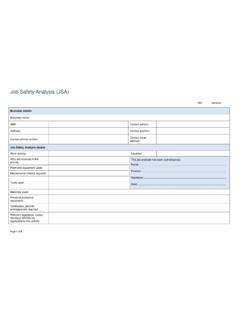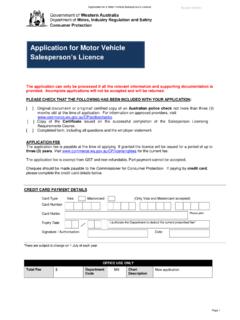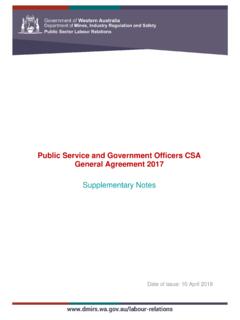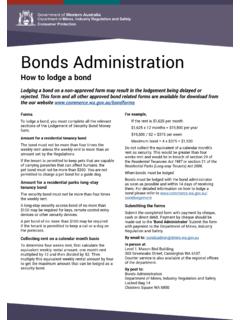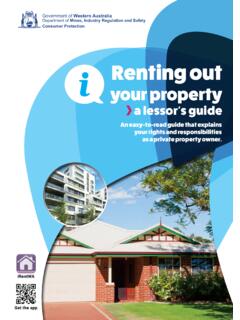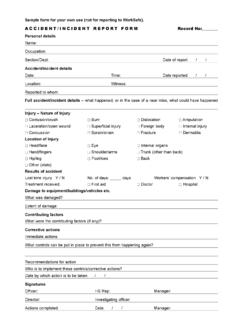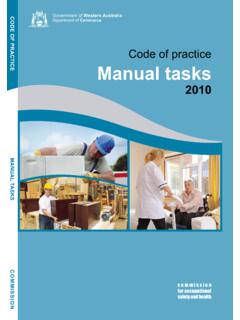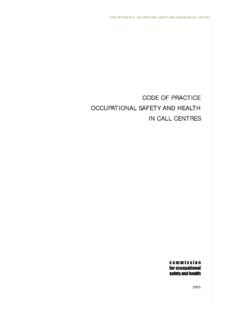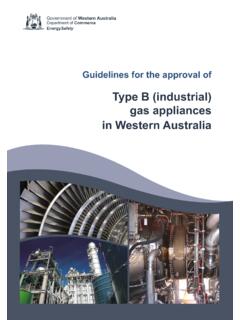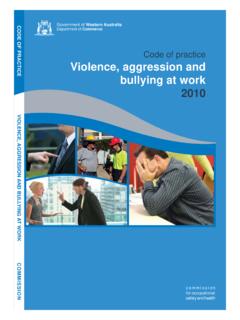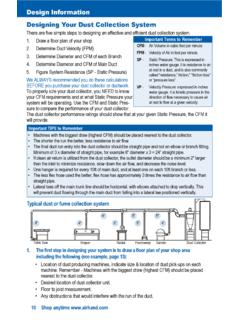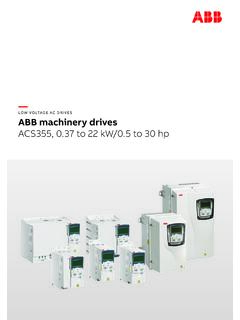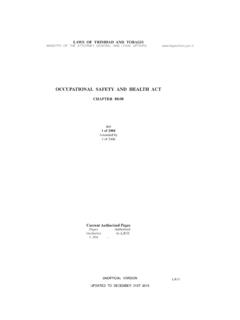Transcription of machinery and equipment safety – an introduction
1 WorkSafemachinery and equipment safety an introduction1st editionWorksafeinfoline 1300 307 877(for the cost of a local call statewide)Westcentre 1260 Hay Street West Perth Western Australia 6005 PO Box 294 West Perth Western Australia 6872 Administration: (08) 9327 8777 Facsimile: (08) 9321 8973 National Relay Service: 13 36 77 Website: : Regional officesGoldfields/Esperance (08) 9021 5966 Great Southern (08) 9842 8366 Kimberley (08) 9169 2811 Mid-West (08) 9964 5644 North-West (08) 9185 0900 South-West (08) 9722 2888 This publication is available in other formats to assist people with special January 2008 - 2000 introduction ..11. Key principles of machinery and equipment safety ..2 1 .1 Mechanical hazards.
2 3 1 .2 Non-mechanical hazards ..4 1 .3 Access hazards ..52. Risk control of machinery and equipment hazards ..7 2 .1 Risk control of machinery and equipment hazards (general) ..8 2 .2 Risk control of mechanical hazards ..9 2 .3 Risk control of non-mechanical hazards ..13 2 .4 Risk control of access hazards ..143. Purchasing machinery and equipment list .. 184. Information and guidance: Where to get more information and assistance ..20contentsAcknowledgementWorkSafe Western Australia acknowledges WorkSafe Victoria for the original development of this publication .DisclaimerInformation in this publication is provided to assist people in meeting their occupational safety and health obligations . While information is correct at the time of printing, readers should check and verify any legislation referenced in this publication to ensure it is correct at the time of use.
3 Changes in law after this document is published may impact upon the accuracy of information . This information is provided as a service to the community . It is made available in good faith and is derived from sources believed to be reliable and accurate at the time of publication . machinery AND equipment safety AN introduction 1 IntroductIonMachinery and equipment safety : An introduction is provided in accordance with the Occupational safety and Health Act 1984 (OHS Act) to assist employers and employees comply with their duties and obligations. This guide is an introduction to managing the risks associated with use of machinery and equipment in the can use this guide to: identify machinery and equipment hazards in the workplace eliminate or reduce the risk of those hazards causing guide will also be useful to anyone else who is interested in machinery and equipment safety , such as employees and safety and Health also has additional guidance supporting all topics introduced in this document.
4 To find out more or to seek further technical information with regard to your machinery and equipment , refer to Section 4 of this employees and safety and H ealtH representatIvesConsultative processes allow people to provide input and raise potential safety concerns about the work they undertake. Although hazards associated with machinery and equipment are often easily identified, the ways in which people can gain access to, or may be exposed to, hazards require a detailed understanding of how they do their machinery AND equipment safety AN INTRODUCTIONKey prIncIples of macHI nery and equipment safety1rIsKs assocIated Mechanical hazards that cannot be eliminated must be controlled to prevent 2 Non-mechanical hazards that cannot be eliminated must be controlled to prevent harmful 3 Access hazards that cannot be eliminated must be controlled to provide safe access (for operation, maintenance, repair, installation, service, cleaning or decommissioning).
5 machinery AND equipment safety AN introduction mecHanIcal HazardsMachines have moving parts. The action of moving parts may have sufficient force in motion to cause injury to reviewing machinery and equipment for possible mechanical hazards, consider: machinery and equipment with moving parts that can be reached by people machinery and equipment that can eject objects (parts, components, products or waste items) that may strike a person with sufficient force to cause harm machinery and equipment with moving parts that can reach people such as booms or mechanical appendages (arms) mobile machinery and equipment , such as forklifts, pallet jacks, earth moving equipment , operated in areas where people may gain mechanical hazards and associated risks for machinery and equipment are shown InformatIonCommission for Occupational safety and Health guidance notes.
6 Plant in the workplace Powered mobile plant Safe movement of vehicles at workplaces Working safely with forklifts Robotic arms can reach over their base, move with remarkable speed and high force, and can cause injury if controls to separate people from moving plant are not plant operated in areas where people work may cause injury through collision. Traffic control and segregation are forms of prIncIples of machinery and equipment safetyHazardrIsKRotating shafts, pullies, sprockets and gearsEntanglementHard surfaces moving togetherCrushingScissor or shear actionSeveringSharp edge moving or stationaryCutting or puncturingCable or hose connectionsSlips, trips and falls ( oil leaks)4 machinery AND equipment safety AN INTRODUCTIONKey prIncIples of machinery and equipment non-mecHanIcal HazardsNon-mechanical hazards associated with machinery and equipment can include harmful emissions, contained fluids or gas under pressure, chemicals and chemical by-products, electricity and noise , all of which can cause serious injury if not adequately controlled.
7 In some cases, people exposed to these hazards may not show signs of injury or illness for years. Where people are at risk of injury due to harmful emissions from machinery and equipment , the emissions should be controlled at their reviewing machinery and equipment for possible non-mechanical hazards, consider how machines and equipment can affect the area (environment) around non-mechanical hazards are shown InformatIonCommission for Occupational safety and Health codes of practice: Managing noise at workplaces Spray painting Commission for Occupational safety and Health guidance notes:Controlling wood dust hazards Controlling Isocyanate hazards at work Prevention of carbon monoxide poisoning from petrol and gas powered equipmentMaterial safety data sheets non-mecHanIcal HazardsDustMist (vapours or fumes)Explosive or flammable atmospheresNoiseHeat (radiated or conducted)Ignition sources (flame or spark)High intensity light (laser, ultra-violet)Molten materialsHeavy metals (lead, cadmium, mercury)ChemicalsSteamPressurised fluids and gasesIonising radiation (x-rays, microwaves)
8 ElectricalWoodworking dust generated by a buzzer is removed via forced extraction and fumes are extracted via flexible, locatable forced extraction and ventilation AND equipment safety AN introduction 5 Key prIncIples of machinery and equipment access HazardsPeople must be provided with safe access that is suitable for the work they perform in, on and around machinery and equipment . A stable work platform suited to the nature of the work that allows for good posture relative to the work performed, sure footing, safe environment and fall prevention (if a fall may occur) is a basic an example, cooling towers on building roofs may have poor access, yet must be attended by a service person at predictable times for water treatment, chemical dosing or monitoring of automated dosing equipment .
9 People performing these tasks must be provided with the means to get themselves and any equipment they require onto the roof with no risk or minimal risk of fall or thinking about safe access to machinery and equipment , think about how, who, when and what: who will be working on or around the machinery and equipment ? people required to work in enclosed areas where the atmosphere could be harmful, such as pits, tanks or storage vessels? what equipment or materials need to be carried to undertake the task? where and when is access required for operation, maintenance and cleaning? how will people gain safe access (walkway, gantry, elevated work platform or ladder)?
10 What work will be carried out during access? will people be near or exposed to an unidentified mechanical or non-mechanical hazard at the time of access? has consultation occurred with employees or contractors regarding how they intend to gain access, and what equipment and work platform or structure is best suited for the intended task?accessAccess needs can be predicted and access planning must occur in need access to machinery and equipment in the workplace (either continually or occasionally) for tasks such as operation, maintenance, repair, installation, service or cleaning. These tasks are examples of access that can be predicted. Access may vary during each stage of machinery and equipment life cycle.
